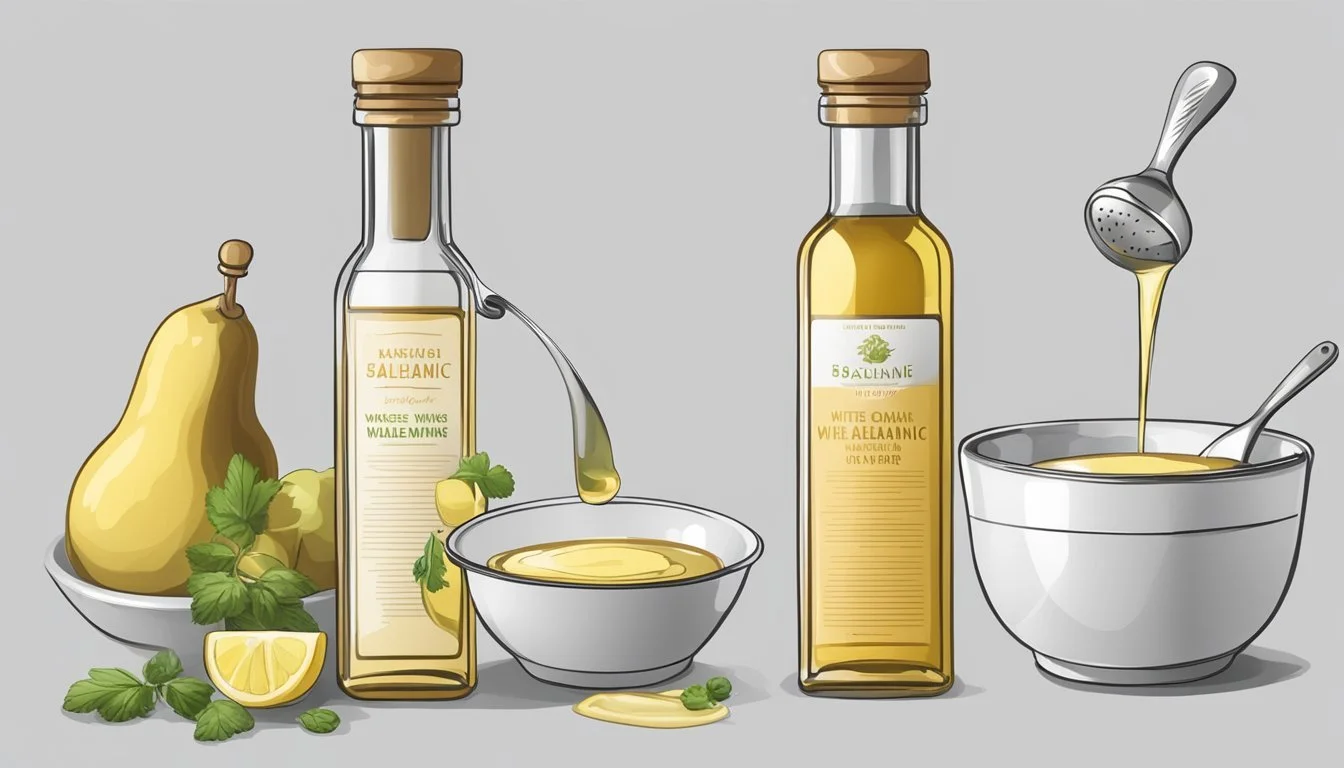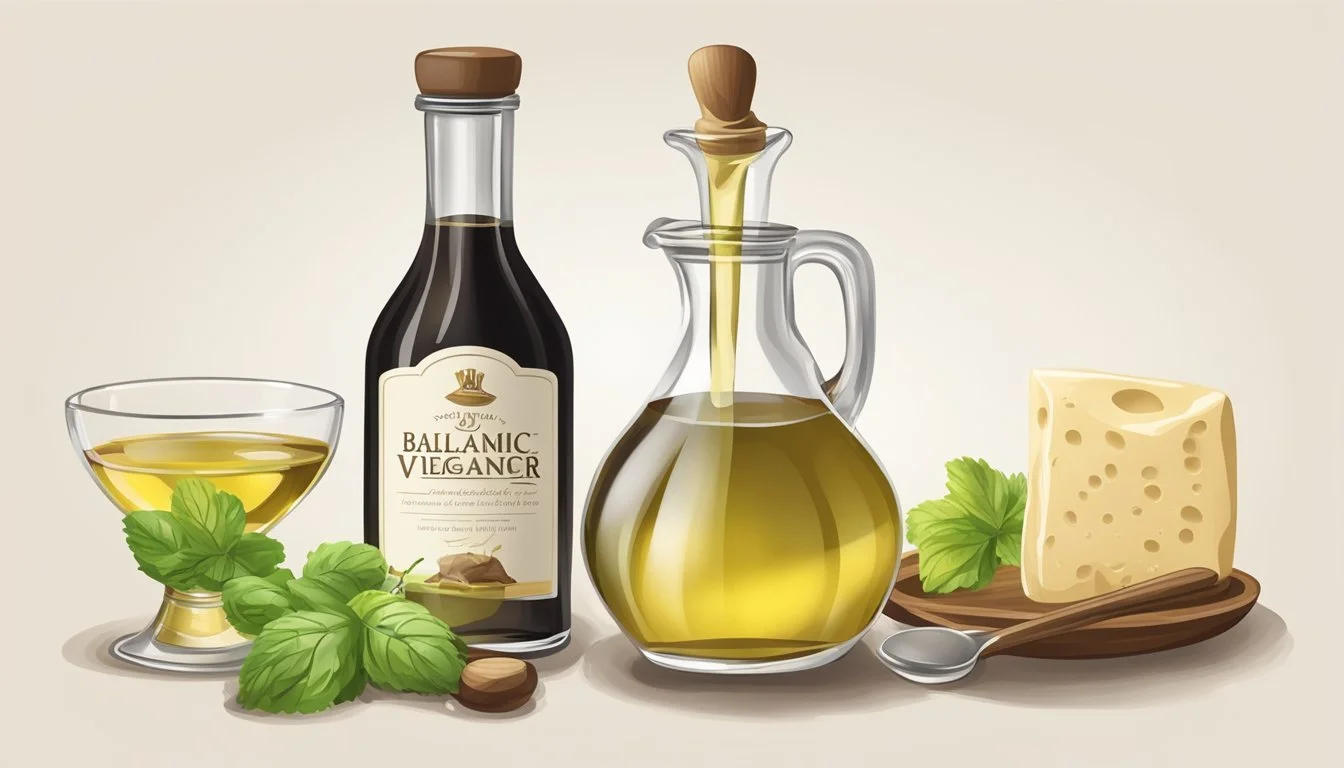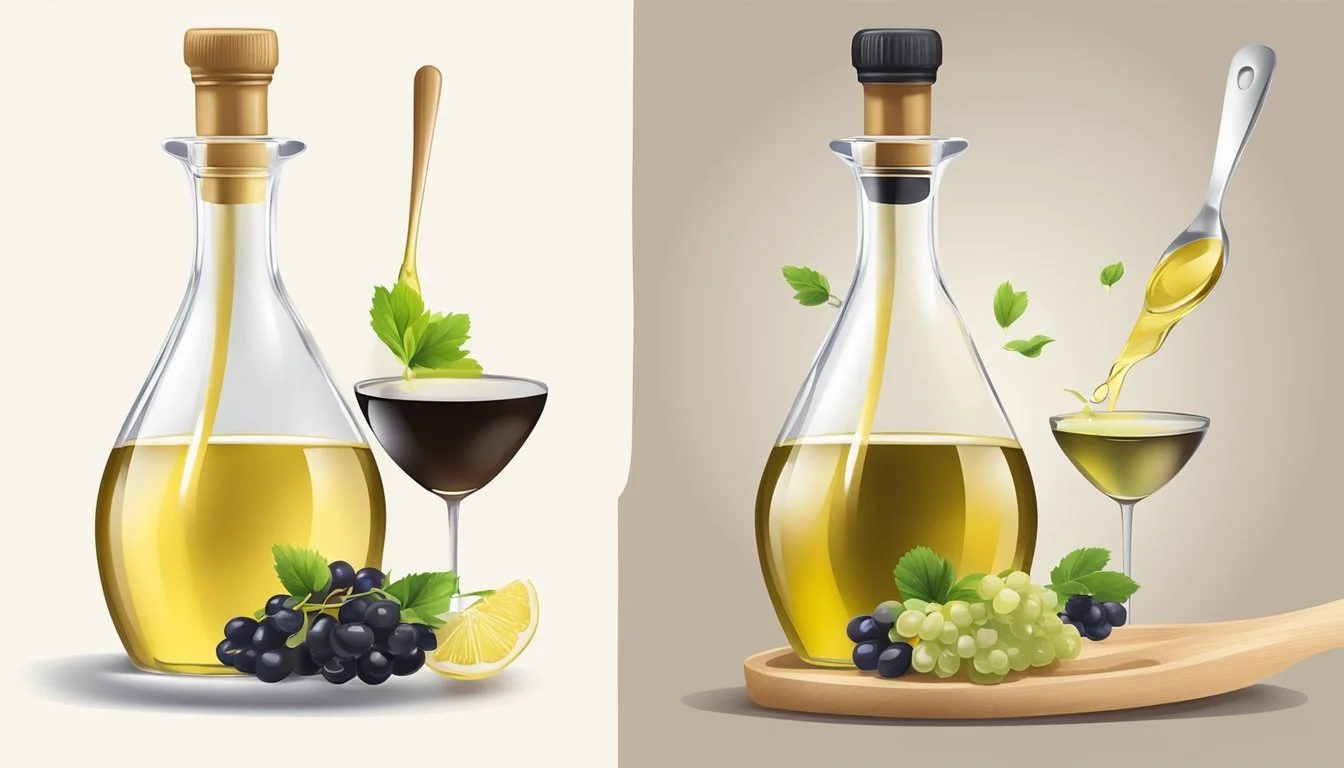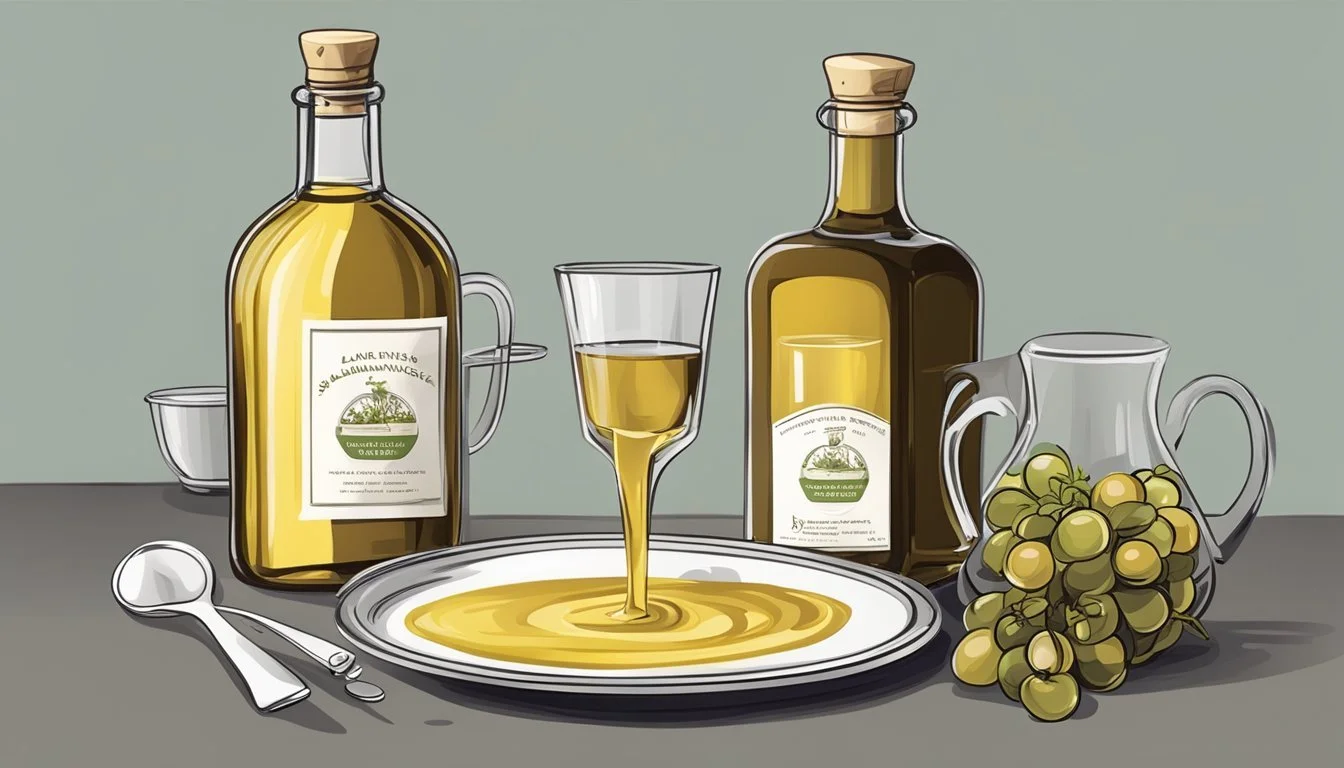How to Substitute White Balsamic Vinegar for White Wine Vinegar
A Simple Guide
White balsamic vinegar and white wine vinegar are both popular ingredients in culinary practices, elevating the flavors of various dishes with their unique properties. Although they share a common color, their flavors are quite distinct, which can impact the taste of a recipe if one is used as a substitute for the other. White balsamic vinegar is known for its slightly sweeter and more subtle flavor compared to the sharp and robust tang of white wine vinegar.
When substituting white balsamic vinegar for white wine vinegar, it's essential to consider the intended balance of flavors in the dish. White balsamic vinegar can often be used in a 1:1 ratio in place of white wine vinegar, but adjustments may be necessary based on the recipe and desired outcome. Since white balsamic is naturally sweeter, reducing the amount of sweet ingredients, or adding a bit of additional acidity, may achieve a closer match to the original flavor profile.
Successful substitution also depends on the type of recipe involved. White balsamic vinegar's milder taste makes it a suitable alternative in salad dressings, marinades, and sauces where a gentle tang is preferred. Conversely, when a robust vinegar presence is desired or when the vinegar's acidity is needed to balance other elements in a dish, a thoughtful approach to substitution becomes imperative to maintain the integrity of the dish.
Understanding Vinegar in Cooking
Vinegar's role in cooking spans a variety of applications, from imparting distinct flavors to manipulating a dish’s acidity. This section dives into how vinegar is utilized in recipes, particularly focusing on white wine vinegar, its flavor profile, and the pivotal role of acidity in culinary creations.
Roles of Vinegar in Recipes
Vinegar is a versatile ingredient in the culinary world, serving multiple roles in recipes. In sauces and salad dressings, it provides a sharp contrast to the richness of oils, enhancing the overall flavor. For marinades, vinegar acts as a tenderizing agent, breaking down proteins in meats and infusing them with flavor. As a seasoning, it can brighten dishes, including soups and stews, teasing out flavors that might otherwise be muted.
Sauces/Dressings: Enhances flavor; contrasts richness
Marinades: Tenderizes; infuses with flavor
Seasoning: Brightens soups and stews
Flavor Profile of White Wine Vinegar
White wine vinegar, noted for its subtle and slightly tangy flavor, presents a milder taste compared to its balsamic and red wine counterparts. It tends to complement rather than overpower the natural flavors of ingredients within a dish. This makes it an excellent choice for delicate sauces and dressings where the aim is to add a hint of acidity without a strong vinegar presence.
Taste: Subtle, slightly tangy, milder than balsamic or red wine vinegar
Uses: Delicate sauces, dressings, where gentle acidity is required
Importance of Acidity in Culinary Creations
Acidity is a critical element in balancing the flavors of a dish. It can cut through richness, cleanse the palate, and even help certain flavors to stand out. In culinary creations, white wine vinegar is often chosen for its ability to introduce the desired level of acidity without altering the dish's intended flavor profile. Proper use of white wine vinegar can transform a recipe, imparting a bright, clean finish that elevates the overall taste.
Balances Flavors: Cuts through richness; highlights flavors
Transforms Recipes: Adds bright, clean finish without altering flavor profile
White Balsamic Vinegar Basics
In exploring the essentials of white balsamic vinegar, it's fundamental to comprehend its distinct production method and the resulting flavor characteristics. This knowledge forms the cornerstone of an informed substitution.
Production and Aging Process
White balsamic vinegar originates from Italy and is crafted utilizing a specialized process. It begins with the selection of white grape must, which is the freshly crushed grape juice with all the skins, seeds, and stems. The grape must is then subjected to a controlled fermentation process. The stark difference between white and regular balsamic vinegar lies in the ageing process. White balsamic is aged for a much shorter period, typically only one to three years in stainless steel or light wood barrels. This preserves its light color and maintains a mild acidity.
Taste and Color Characteristics
The flavor profile of white balsamic vinegar is notably sweet and subtle compared to its darker counterpart. Due to its minimal aging, white balsamic retains a clearer, pale gold appearance, which avoids discoloring dishes. This attribute makes it an excellent choice for maintaining the visual appeal of sauces, dressings, and light-colored foods. The flavor is balanced, with a gentle complexity that does not overpower other ingredients.
Substituting Vinegar Varieties
Substituting vinegar varieties requires understanding the flavor profile and acidity of each vinegar. When replacing white balsamic vinegar with white wine vinegar, adjustments are often necessary to mimic the sweetness and acidity of the original ingredient.
When to Substitute
When a recipe calls for white balsamic vinegar, one can substitute it with white wine vinegar if the latter is more readily available. White wine vinegar is suitable for vinaigrettes, marinades, and sauces. However, it is important to note that white wine vinegar is tangier and less sweet than white balsamic vinegar.
How to Adjust for Sweetness and Acidity
To adjust white wine vinegar to more closely resemble the sweeter, milder profile of white balsamic vinegar, consider the following steps:
Sweetness: Add sugar or honey to white wine vinegar. Begin with a ratio of 1/4 teaspoon of sweetener per tablespoon of vinegar and adjust to taste.
Acidity: Dilute the white wine vinegar with water to lower the acidity level. Start with a mixture of 3 parts vinegar to 1 part water.
Table for Sweetness Adjustment:
Ingredient Quantity Replacement Quantity White Wine Vinegar 1 tbsp 1 tbsp + 1/4 tsp sugar/honey
Adjustments should be made gradually, tasting the blend to ensure the desired flavor balance is achieved for the recipe at hand.
Alternative Vinegar Options
When substituting white balsamic vinegar, various vinegars can replicate its fruity and light taste in cooking. They offer versatility across a range of culinary uses, from dressings to marinades.
Cider and Rice Vinegar in Cooking
Apple cider vinegar is a popular ingredient known for its slightly fruity flavor, making it an excellent substitute in salads and vinaigrettes. It can be used in a 1:1 ratio when replacing white balsamic vinegar, especially in dishes where a hint of apple flavor complements the overall taste. Rice vinegar, another milder vinegar, lends a delicate acidity to dishes, perfect for stir-fries and Asian-inspired dressings.
Using Fruit Vinegars
Fruit vinegars, like raspberry or pear vinegar, infuse a unique fruitiness into culinary creations. They should be used judiciously as they are more potent in flavor. Begin with a smaller quantity than the recipe calls for white balsamic vinegar, and adjust to taste. Their use in fruity vinaigrettes can elevate the flavor profile of simple salads.
Red and Champagne Vinegar Uses
Red wine vinegar, with its robust flavor, is less sweet but still a suitable option for heartier dishes where its boldness won't overpower. Champagne vinegar stands out with a delicate and light taste, making it a closer match to white balsamic vinegar. It works splendidly in subtle dressings or when a gentle tang is desired without a strong vinegar presence.
Application in Recipes
When substituting white balsamic vinegar for white wine vinegar, the goal is to achieve the unique balance between tartness and slight sweetness that white wine vinegar provides. This balancing act is crucial across various recipes where the vinegar's character is prominent.
White Balsamic in Dressings and Marinades
In dressings and marinades, white balsamic vinegar imparts a syrupy consistency and a tangy flavor that is both tart and subtly sweet. As a guideline:
Salad Dressings: For a bright vinaigrette, mix white balsamic vinegar with olive oil, a dollop of mustard for emulsification, and a pinch of salt. Its slightly sweet profile enhances garden salads or drizzles for roasted vegetables.
Marinades: When marinating proteins like chicken or fish, the acidity of white balsamic vinegar can tenderize effectively while the syrupy quality adds a layer of flavor.
Enhancing Dishes with Substitute Vinegars
Various dishes benefit from the unique properties of white balsamic vinegar, much like they do from white wine vinegar. When using substitutes:
Acidic Component in Dishes: Introduce white balsamic vinegar gradually, starting with a 1:1 ratio and adjust based on the desired level of tanginess.
Sweetener Adjustment: Since white balsamic is sweeter, reduce or omit other sweeteners in the recipe to maintain balance.
Creating Sweet and Tangy Sauces
Sauces that require a balance of sweetness and acidity can be effectively crafted with white balsamic vinegar. Its tangy taste shines in:
Reductions: Simmer white balsamic vinegar until thickened for a glaze akin to balsamic reduction, perfect for drizzling over meats or strawberries.
Salsas and Fruit Sauces: The vinegar’s fruity notes can compliment ingredients such as tomatoes and peaches, adding complexity and depth.
White balsamic vinegar's versatility in the kitchen makes it a valuable ingredient for crafting compelling dressings, marinades, and sauces, adding a touch of elegance to everyday dishes.
Practical Tips for Substitution
When substituting white balsamic vinegar with white wine vinegar, the key lies in mimicking the sweet and mellow profile of the original ingredient. Adjustments in sweetness and acidity should be made mindfully to achieve a similar flavor.
Adjusting the Flavor Balance
White wine vinegar is more acidic and less sweet than white balsamic vinegar. To replicate the milder, sweeter taste when using white wine vinegar as a substitute, one should start with a 1:1 ratio and then adjust for sweetness and acidity. It’s recommended to experiment carefully, adding sweetness in small increments. For those who prefer a more nuanced flavor, the use of additional sweetening ingredients can fine-tune the balance.
Alternative Sweetening Ingredients
To complement the sharper taste of white wine vinegar, incorporating sweeteners is essential. The choice of sweetener can greatly affect the outcome:
Sugar: Begin by adding a teaspoon of sugar for every tablespoon of white wine vinegar, stirring thoroughly and tasting the mixture.
Honey: A natural alternative that can impart a smooth sweetness. Add honey sparingly, as its flavor is stronger than sugar.
By considering these elements, cooks can create a substitute that closely mirrors the sweetness and flavor profile of white balsamic vinegar.
Additional Considerations
When substituting white balsamic vinegar with white wine vinegar, it’s crucial to consider not just taste but also how this change affects the dish’s aesthetic and nutritional profile.
Culinary Aesthetic Elements
Color: The light color of white wine vinegar preserves the visual appeal in dishes where clarity is desired. It is especially important in recipes like seafood or sushi, where a clean, clear appearance is preferred.
List of Vinegars by Color Intensity:
White wine vinegar: Light color
Malt vinegar: Darker hue
Chinese black vinegar: Robust, deep color
Texture: White wine vinegar has a similar watery texture to white balsamic, ensuring that the consistency of your culinary creations remains as intended.
Health and Nutritional Aspects
Vitamin Content: Vinegars typically do not contribute significant amounts of vitamins to dishes; their role is primarily flavor enhancement rather than nutritional supplementation.
Table Comparing Vinegar Types:
Vinegar Type Acidity Level Suggested Culinary Uses White Wine Vinegar Medium-High Dressings, marinades, fine sauces Chinese Black Vinegar Low-Medium Stir-fries, braising, dipping Malt Vinegar Medium-Low Pickling, robust marinades
Each variety imparts its unique taste and may slightly alter the flavor profile, so one should adjust other seasonings in the dish accordingly. For example, adding white wine vinegar in place of white balsamic may require a touch of sweetness to achieve balance.
Exploring Cultural Vinegar Varieties
In the realm of vinegars, the variety and complexity found across cultures reflect centuries of culinary traditions. This section will explore the rich history and unique characteristics of Italy's traditional balsamic vinegar and delve into other distinctive vinegars from around the world.
Traditional Balsamic from Italy
Traditional balsamic vinegar ('Aceto Balsamico Tradizionale') hails from the regions of Modena and Reggio Emilia in Italy. It is a highly regarded condiment, crafted from the reduction of cooked white Trebbiano grape juice, known as 'must.' This must is then aged for years, and in some instances, decades, in a series of wooden barrels. The aging process allows it to develop a full-bodied depth, a complex, robust flavor, and a fruity undertone that distinguishes it from regular balsamic vinegar. The wood from the barrels contributes to its unique flavors and characteristics:
Oak: Adds strength and character
Cherry: Imparts a fruity essence
Chestnut: Bestows tannins and a rich color
Mulberry: Lends sweetness
The process creates a traditional balsamic that is both flavorful and viscous, ideal for drizzling over dishes to enhance their flavor profiles.
Unique Vinegars Around the World
Different cultures have produced a remarkable array of unique vinegars, each with its own place in local culinary practices:
Sherry Vinegar (Spain): Comes from the sherry wine and has a nutty, mild flavor.
Champagne Vinegar (France): Derived from champagne, it's light and has a delicate flavor.
Rice Vinegar (Asia): Features prominently in Asian cuisine; it is less acidic with a subtle sweetness.
Apple Cider Vinegar (Global): Made from fermented apple juice, it is versatile and widely used.
Each type of vinegar carries its own distinct taste and is often chosen to complement the cultural dishes it is used in, creating a harmonious balance of flavors that is specific to its origin.
Advanced Techniques and Tips
In the realm of culinary expertise, the substitution of white balsamic vinegar for white wine vinegar involves a nuanced understanding of flavor, texture, and the ways that various vinegars react during cooking processes.
Professional Approaches to Vinegar Use
Professionals often employ a spectrum of vinegars to elevate their dishes, recognizing the distinctive characteristics each one brings. When using white wine vinegar as a substitute for white balsamic, a chef may take into account the fermented quality of both vinegars. White balsamic vinegar undergoes a different aging process than its darker counterpart, but retains a delicate sweetness that fermented red wine vinegar lacks. When substituting in recipes like marinades that aim to tenderize and flavor meat, a culinary professional might mix white wine vinegar with a hint of sugar or honey to mimic the milder, slightly sweet profile of white balsamic vinegar.
White Balsamic Vinegar White Wine Vinegar Substitute Ratio Added Sweetener (optional) 1 tbsp 1 tbsp 1:1 ¼ tsp of sugar or honey
Caramelization and Textural Enhancements
A chef understands how the caramelization process can be manipulated by choice of vinegar. White balsamic vinegar, with its inherent sweetness, contributes to a quicker caramelization of ingredients like onions or root vegetables. To achieve a similar effect with white wine vinegar, which is sharper, the professional might adjust cooking times or add sweeteners to balance the sharpness. Concerning texture, white balsamic's thicker consistency can be important in dressings and glazes. Here, distilled white vinegar, which is more acidic and less viscous than grain vinegars, might require careful blending with a thicker agent to mimic the desirable consistency of white balsamic vinegar in glazing culinary creations.
By considering the unique properties of the vinegar at hand and making precise adjustments, chefs can create a harmonious balance in their dishes, ensuring that both flavor and texture meet their exacting standards.








